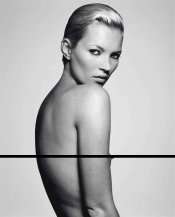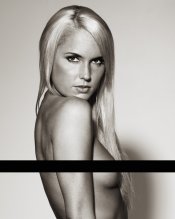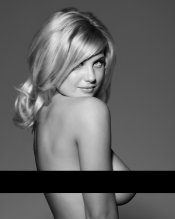Would it be a case of doing a pre-flash to build up the extra tone over the whole image? Or is it more a case of lighting involved?
I'd be inclined to say that it's mostly the lighting setup, assuming that things were relatively straightforward. (Sometimes something that appears simple turns out to not be so at all.)
I don't really agree that there is a large light source, but DO agree with foc's idea of black "reflectors" or baffles, or whatever. So I'll just go through my line of thinking. I should probably mention, though, that my main experience has been in color portrait work - the sort where the customer is the subject, so it's the sort of thing whereas you want to make them look "good," in a more traditional sort of way.
The first thing I'd look at here is the lighting, starting with the most obvious things. Ok, I only see one light, judging by the shadows, under the nose, under the jawline (camera left), etc. These shadows are pronounced, so I know it's not a large, soft source. But neither are the shadows hard and crisp, like in direct sun, so I know it's not a tiny light source. I'd make the guess that it's something on the order of a 10" or 15" reflector with diffusion material on the front, and it's relatively close, on the order of 3 to 5 feet from the model's face.
For the location of the single light, the shadows give clues. I know that it's above the center of her face because the shadows are below her nose. But the shadows do not go way down, meaning that the light is only slightly to moderately higher. Now, what about side-to-side; is it right or left? Well, the nose shadow suggests that the light is from camera left, but.. since her face is turned sideways this is deceptive. The light actually seems closer to center, or slightly camera right (look at her arm, up and down, near center of frame - more shadowed on the camera left). Now, how far away is the light? Well, with just the face we can't tell. But it's clear that the light is falling off farther down her arm, which won't happen if the light is far away. So we know what it's moderately close to the model. We also see that the light can't reach the lower part of her back, which also supports the idea that the light is fairly close. So my guess is that this light is something like a 10-15" diameter diffused disk, about 3 to 5 feet from the subjects, and roughly 10 to 20 inches above her eye level, slightly to camera right.
Something else I would do, after guessing at the main light, is to set if specular reflections confirm this. They don't. There are no catch lights in the eyes. Nor are there obviously specular reflections from the skin, even though a smallish light source like this ought to produce such. It's possible that her skin was heavily matted down, or perhaps the shine was retouched out. But in the interest of simplicity I would wonder if this is just a characteristic of the film being used (assuming that it even IS film). If this was a film/developer combination where the "response" (per characteristic curve) is rolling off in the flesh highlight area, then I'd expect to see only slight amounts of specular reflection. The sample image doesn't really show fine enough detail to be sure, but if things were done in a simple manner, this would be my best guess.
Now, onto the background, etc. Given that the main light is fairly close to camera axis, I next wonder, where is the subject's shadow on the background? I don't see any trace of one, so presumably the BG is far enough away that the shadow misses. How far? I dunno, but if it's a long distance, perhaps a BG light was used. Or maybe not.
Lastly, the depth of the shadows on the subject's sides. This means there is almost no fill light there. But if a large white BG is used, this alone tends to flood the studio with light, and some stray light invariably kills the darkness of those shadows. Even the specular nature of skin would tend to pick up some reflection from the edges of the background. So one presumes that either a narrow white background was used in a "blacked out" studio, or it was a more conventional studi setup with some large black baffles near the subject.
So if this is how it was done, rather than with extensive image manipulation, then it ought to be relatively simple to print. Again, this is all just guesswork; it would be interesting to see how close I actually got. But I suspect these photos were a long time ago, and likely no one remembers.











 I figure it could be a case the lighting gently falling off with typical inverse square law, etc.
I figure it could be a case the lighting gently falling off with typical inverse square law, etc.

